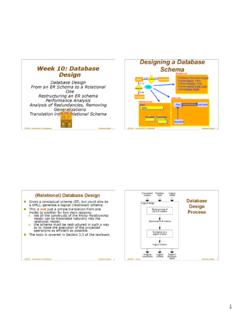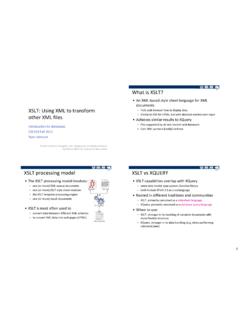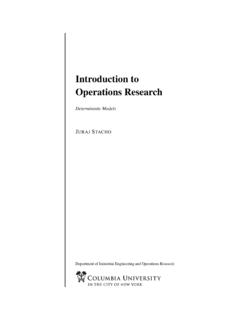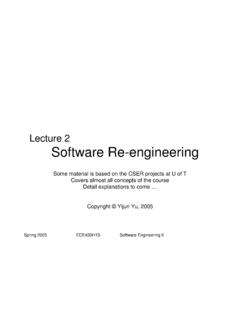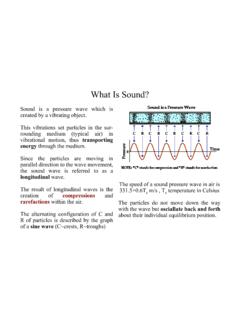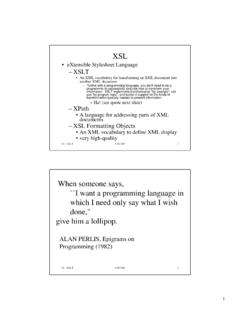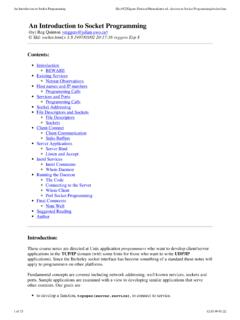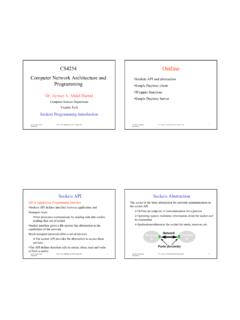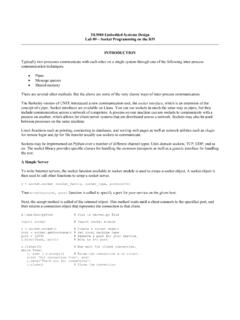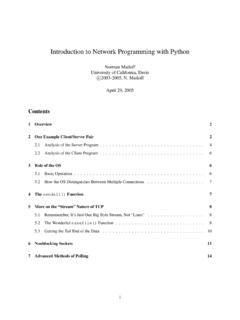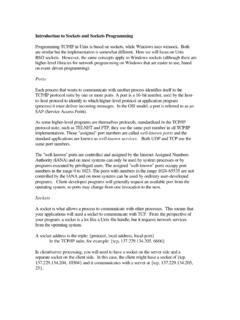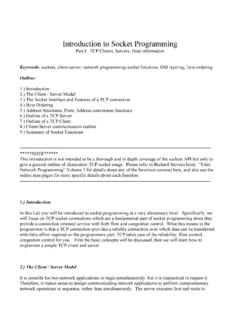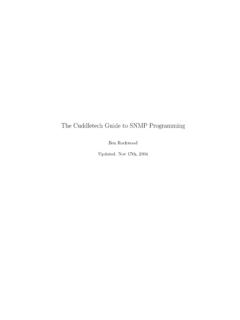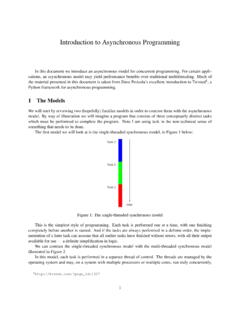Transcription of Tutorial on Socket Programming - University of Toronto
1 1 Tutorial on Socket ProgrammingComputer Networks -CSC 458 Department of Computer SciencePooyanHabibi(Slides are mainly from SeyedHossein Mortazavi, Monia Ghobadi, and Amin Tootoonchian, ..)2 Outline Client-server paradigm sockets Socket Programming in UNIX3 End System: Computer on the NetInternetAlso known as a host ..4 Clients and ServersClient program Running on end host Requests service , Web browserServer program Running on end host Provides service , Web serverGET Site under construction 5 Client-Server CommunicationClient Server Always on Serve services to many clients , Not initiate contact with the clients Needs a fixed address Sometimes on Initiates a request to the server when interested , web browser Needs to know the server s address6 Socket : End Point of CommunicationProcesses send messages to one another Message traverse the underlying networkA Process sends and receives through a Socket Analogy: the doorway of the house.
2 Socket , as an API, supports the creation of network applicationssocketsocketUser processUser processOperatingSystemOperatingSystem7 UNIX Socket APIS ocket interface A collection of system calls to write a networking program at user-level. Originally provided in Berkeley UNIX Later adopted by all popular operating systemsIn UNIX, everything is like a file All input is like reading a file All output is like writing a file File is represented by an integer file descriptor Data written into Socket on one host can be read out of Socket on other hostSystem calls for sockets Client: create, connect, write, read, close Server: create, bind, listen, accept, read, write, close8 Typical Client ProgramPrepare to communicate Create a Socket Determine server address and port number Why do we need to have port number?9 Using Ports to Identify ServicesWeb server(port 80)Client hostServer host server(port 7)Service request :80( , the Web server)Web server(port 80)Echo server(port 7)Service request :7( , the echo server)OSOSC lientClient10 Socket ParametersA Socket connection has 5 general parameters: The protocol Example: TCP and UDP.
3 The local and remote address Example: The local and remote port number Some ports are reserved ( , 80 for HTTP) Root access require to listen on port numbers below 102411 Typical Client ProgramPrepare to communicate Create a Socket Determine server address and port number Initiate the connection to the serverExchange data with the server Write data to the Socket Read data from the Socket Do stuff with the data ( , render a Web page)Close the socket12 Important Functions for Client Program Socket () create the Socket descriptor connect() connect to the remote server read(),write() communicate with the server close()end communication by closing Socket descriptor13 Creating a Socketintsocket(intdomain, inttype, intprotocol) Returns a descriptor (or handle) for the Socket Domain: protocol family PF_INET for the Internet Type: semantics of the communication SOCK_STREAM: Connection oriented SOCK_DGRAM: Connectionless Protocol: specific protocol UNSPEC: unspecified (PF_INET and SOCK_STREAM already implies TCP) , TCP: sd= Socket (PF_INET, SOCK_STREAM, 0); , UDP: sd= Socket (PF_INET, SOCK_DGRAM, 0).
4 14 Connecting to the Server intconnect(intsockfd, structsockaddr*server_address, socketlen_taddrlen) Arguments: Socket descriptor, server address, and address size Remote address and port are in structsockaddr Returns 0 on success, and -1 if an error occurs15 Sending and Receiving DataSending data write(int sockfd, void *buf, size_t len) Arguments: Socket descriptor, pointer to buffer of data, and length of the buffer Returns the number of characters written, and -1 on errorReceiving data read(int sockfd, void *buf, size_t len) Arguments: Socket descriptor, pointer to buffer to place the data, size of the buffer Returns the number of characters read (where 0 implies end of file ), and -1 on errorClosing the Socket int close(int sockfd)16 Byte Ordering: Little and Big EndianHosts differ in how they store data , four-byte number (byte3, byte2, byte1, byte0)Little endian ( little end comes first ) Intel PCs!
5 !! Low-order byte stored at the lowest memory location byte0, byte1, byte2, byte3 Big endian ( big end comes first ) High-order byte stored at lowest memory location byte3, byte2, byte1, byte 0IP is big endian (aka network byte order ) Use htons() and htonl() to convert to network byte order Use ntohs() and ntohl() to convert to host order17 Servers Differ From ClientsPassive open Prepare to accept connections .. but don t actually establish one .. until hearing from a clientHearing from multiple clients Allow a backlog of waiting clients .. in case several try to start a connection at onceCreate a Socket for each client Upon accepting a new client .. create a new Socket for the communication18 Typical Server ProgramPrepare to communicate Create a Socket Associate local address and port with the socketWait to hear from a client (passive open) Indicate how many clients-in-waiting to permit Accept an incoming connection from a clientExchange data with the client over new Socket Receive data from the Socket Send data to the Socket Close the socketRepeat with the next connection request19 Important Functions for Server Program Socket () create the Socket descriptor bind()associate the local address listen()wait for incoming connections from clients accept()accept incoming connection read(),write()communicate with client close()
6 Close the Socket descriptor20 Socket Preparation for Server ProgramBind Socket to the local address and port intbind (intsockfd, structsockaddr*my_addr, socklen_taddrlen) Arguments: Socket descriptor, server address, address length Returns 0 on success, and -1 if an error occursDefine the number of pending connections intlisten(intsockfd, intbacklog) Arguments: Socket descriptor and acceptable backlog Returns 0 on success, and -1 on error21 Accepting a New Connectionint accept(int sockfd, struct sockaddr *addr, socketlen_t *addrlen) Arguments: Socket descriptor, structure that will provide client address and port, and length of the structure Returns descriptor for a new Socket for this connection What happens if no clients are around? The accept()call blocks waiting for a client What happens if too many clients are around? Some connection requests don t get through.
7 But, that s okay, because the Internet makes no promises22 Server Operation accept() returns a new Socket descriptor as output New Socket should be closed when done withcommunication Initial Socket remains open, can still acceptmore connections23 Putting it All Togethersocket()bind()listen()accept()re ad()write()ServerblockprocessrequestClie ntsocket()connect()write()establishconne ctionsend requestread()send response24 Supporting Function Callsgethostbyname() get address for given hostname ( for name );getservbyname() get port and protocol for agiven service ftp, http ( http is port 80, TCP)getsockname() get local address and local port of a socketgetpeername() get remote address and remote port of a socket25 Useful Structuresstruct sockaddr {u_short sa_family;char sa_data[14];};struct sockaddr_in {u_short sa_family;u_short sin_port;struct in_addr sin_addr;char sin_zero[8];};struct in_addr {u_long s_addr;};Generic address, connect(), bind(), accept() < >Client and server addressesTCP/UDP address(includes port #)< >IP address< >26 Other useful Address conversion routines Convert between system s representation of IP addresses and readable strings ( )unsigned long inet_addr(char* str);char * inet_ntoa(struct in_addr inaddr); Important header files:< >, < >, < >,< > man pages Socket , accept, bind, listen27 Next Tutorial session: Assignment 1 overview Please post questions to the bulletin board Office hours posted on website28 Socket typesStream sockets : Delivery in a networked environment is guaranteed.
8 If you send through the stream Socket three items "A, B, C", they will arrive in the same order -"A, B, C". These sockets use TCP (Transmission Control Protocol) for data transmission. If delivery is impossible, the sender receives an error indicator. Data records do not have any sockets : Delivery in a networked environment is not guaranteed. They're connectionless because you don't need to have an open connection as in Stream sockets -you build a packet with the destination information and send it out. They use UDP (User Datagram Protocol).Raw sockets : These provide users access to the underlying communication protocols, which support Socket abstractions. These sockets are normally datagram oriented, though their exact characteristics are dependent on the interface provided by the protocol. Raw sockets are not intended for the general user; they have been provided mainly for those interested in developing new communication protocols, or for gaining access to some of the more cryptic facilities of an existing Packet sockets : They are similar to a stream Socket , with the exception that record boundaries are preserved.
9 This interface is provided only as a part of the Network Systems (NS) Socket abstraction, and is very important in most serious NS applications. Sequenced-packet sockets allow the user to manipulate the Sequence Packet Protocol (SPP) or Internet Datagram Protocol (IDP) headers on a packet or a group of packets, either by writing a prototype header along with whatever data is to be sent, or by specifying a default header to be used with all outgoing data, and allows the user to receive the headers on incoming packets.
